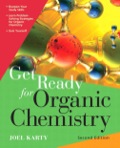
Concept explainers
Interpretation:
In Figure D-8a and D-8b, every region of constructive interference and destructive interference between the HOMO and LUMO is to be labeled.
Concept introduction:
Molecular orbitals are constructed from the AOs of different atoms. When two atoms are brought close enough together (i.e., about a bond length apart), the AOs of one atom significantly overlap the AOs of the other atom, enabling them to undergo constructive and destructive interference, or mix, to produce new orbitals. When two orbitals overlap with the same phases, constructive interference takes place. When two orbitals overlap with the opposite phases, destructive interference takes place. Constructive interference results in a new orbital that is more stable than the σ bonding orbital, and destructive interference results in a new orbital that is less stable than the ρ atomic orbital. Constructive interference predominantly takes place in both Figure D-8a and Figure D-8b.
Want to see the full answer?
Check out a sample textbook solution
Chapter D Solutions
EBK GET READY FOR ORGANIC CHEMISTRY
- Look at the image attached pleaarrow_forwardComplete the mechanismarrow_forwardV Biological Macromolecules Drawing the Haworth projection of an aldose from its Fischer projection Draw a Haworth projection of a common cyclic form of this monosaccharide: H C=O HO H HO H H OH CH₂OH Explanation Check Click and drag to start drawing a structure. Xarrow_forward
- Complete the mechanismarrow_forwardComplete the mechanismarrow_forward8 00 6 = 10 10 Decide whether each of the molecules in the table below is stable, in the exact form in which it is drawn, at pH = 11. If you decide at least one molecule is not stable, then redraw one of the unstable molecules in its stable form below the table. (If more than unstable, you can pick any of them to redraw.) Check OH stable HO stable Ounstable unstable O OH stable unstable OH 80 F6 F5 stable Ounstable X Save For Later Sub 2025 McGraw Hill LLC. All Rights Reserved. Terms of Use | Privacy C ཀྭ་ A F7 매 F8 F9 4 F10arrow_forward
